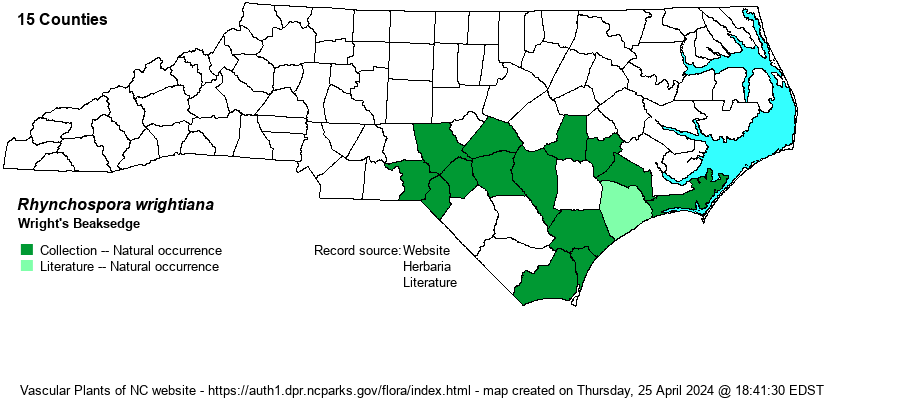| Author | Boeckeler | |
| Distribution | Southern Coastal Plain and Sandhills. As there are a number of records for southeastern VA, it could well occur in some northern NC Coastal Plain counties.
Coastal Plain, southeastern VA to central FL and southern AL; West Indies. | |
| Abundance | Uncommon or rare throughout. Presumed extremely rare in the northern Coastal Plain, where it is to be looked for. This is a Watch List species, though with a Global Rank of G5 and a State Rank of S3, it probably can be removed from that status. | |
| Habitat | Seasonally wet depressions in pine savannas and flatwoods, upper ecotones of blackwater streamheads. |
| Phenology | Flowering and fruiting July-September. | |
| Identification | The very slender stems are no taller than 1.5 feet, erect to leaning. It often has been confused with R. distans, but R. wrightiana differs in the spikelets dark brown (vs. reddish brown), leaves mostly less than 1 mm wide (vs. 1.3 mm or more wide), and the seed beak abruptly narrowed to a central slender extension (vs. simply triangular in R. distans). It may also be confused with R. debilis, but that plant has short seed bristles (at most half as long as the seed body vs. more than half as long in R. wrightiana). | |
| Taxonomic Comments | None
Members of the genus Rhynchospora -- mainly called beaksedges but also called beakrushes -- are mostly Coastal Plain in distribution and are important members of our longleaf pine savannas, flatwoods, streamheads, depression ponds, Carolina bays, and beaver ponds. They vary from small and wiry to large and coarse. Keys concentrate on features of the achenes (seeds) and the shape and arrangement of the flower clusters (spikelets). The seeds may or not have bristles at their base; bristle number, length, and toothing are critical characters. Size and shape of the seed beaks is also critical. The drawings in Godfrey & Wooten (1979) are extremely helpful. The genus now includes Dichromena, the white-topped sedges. | |
| Other Common Name(s) | None | |
| State Rank | S3 | |
| Global Rank | G5 | |
| State Status | W1 | |
| US Status | | |
| USACE-agcp | OBL link |
| USACE-emp | OBL link |

